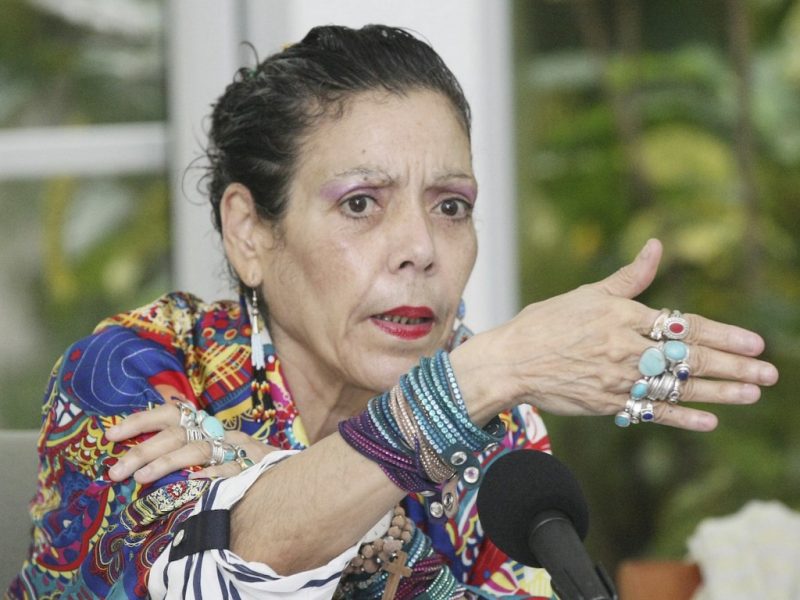VP Murillo Disseminates all Nicaragua Vaccine Information

The vice president, not the Health Ministry, is in charge of all information related to the pandemic.
By Keyling T. Romero (Confidencial)
HAVANA TIMES – In its handling of the COVID-19 pandemic, Nicaragua remains the exception to the rule in Central America. When all other countries imposed restrictive measures, in Nicaragua that never occurred. With the COVID vaccines, the government’s behavior is similar. Nicaragua is the only country that held onto over 300,000 vaccine doses for a month. Like virtually everything else in the country, all vaccine information is centered in one person: Rosario Murillo.
The vice president and only government spokesperson is in charge of informing the public. She does this through her daily monologues that are transmitted on all the government stations. Information she imparts includes: how the vaccination will be carried out, in which departments, which regions, and who is eligible. This system has caused confusion among the population, because the information often lacks clarity.
Initially, Murillo indicated that only those previously selected could be immunized. Then, given the demand from citizens who gathered at the vaccination sites without an appointment, the regime loosened its measures.
“It’s the Ministry of Health’s obligation to share real information regarding the conduct of the disease. They should also be guaranteeing the entire population access to diagnostic tests. We demand to know the national plan for vaccination,” insisted the independent monitoring organization “COVID-19 Citizens’ Observatory”.
The Ministry of Health (Minsa), is charged with administering the vaccination process. The doses Nicaragua received were donated through the Covax mechanism and by the government of India. However, Minsa has yet to present to the public the national vaccination plan.
The plan itself was elaborated, and the document submitted to the Pan American Health Organization (PAHO) last January. Its submission was a requirement for receiving the vaccine donation. Nonetheless, the Minsa website has absolutely no information about the vaccination events that began on April 6th. The Minsa authorities speak only after Murillo does.
“Nicaragua has 40 years of experience in vaccination campaigns. They normally report the dates, the target population, and the vaccines to be applied. After that, they call on the public to support the campaign. On this occasion, not even the health workers in the public sector have been informed. That marks the first time in the history of the country’s public health system. The misinformation creates uncertainty, stress, insecurity, long lines, and unnecessary hours of waiting, doubts and distrust in the health system.” These were the observations of epidemiologist Leonel Arguello, a member of the Multidisciplinary Scientific Committee.
Nicaragua and Venezuela fail to provide information
In the Americas, PAHO employs a mechanism through which all the countries share daily or weekly reports. They regularly inform on how their vaccinations are progressing. The latest report, from April 9th, documents 163.9 million people on the continent who’ve received at least one dose. By far, the largest share of these were from the United States.
However, there’s no information on vaccinations from Nicaragua or Venezuela. Both countries have stood out for the opaque way they’ve handled the pandemic. In the case of Venezuela, there were denunciations and uprisings against Nicolas Maduro’s order to politicize the vaccination distribution.
In the case of Nicaragua, the second round of vaccinations has just begun. During this phase, the regime has allowed the opposition to be among the beneficiaries. However, in some cases those who work at the immunization sites have harassed the dissenting citizens. They’ve posted photos mocking them for exercising their right to health.
In Central America, according to PAHO, 776,165 doses of the COVID-19 vaccine have been given. A total of 401,942 people have now received both shots. There’s no available data from Nicaragua, however.
Vice President Murillo offered detailed accounts of the number of vaccines administered against other illnesses. These vaccines were administered during a campaign that ran parallel to the COVID-19 vaccinations. Only the latter vaccinations remain unreported, although Murillo promised last Monday to reveal the planned distribution of doses to each health center.
Vaccine sites
According to the official information, from April 6 – 30, Minsa expects to vaccinate 167,500 people. In order to achieve this, they’ll transfer part of the Covishield or AstraZeneca doses to the country’s 19 health regions. They’ll then be distributed to certain hospitals, health centers and maternal care homes that are being set up for this task.
In the first week, vaccination sites were set up in the departments of Managua, Leon, Chinandega and Rivas. The second week, which began on April 12th, they’ll be vaccinating in Carazo, Managua, Masaya, Granada, Esteli, Nueva Segovia and Madriz.
Week three, the vaccines will be offered in the departments of Jinotega, Managua, Matagalpa, Boaco and Chontales. The last week, the vaccinations will move to the South Caribbean, Managua Zelaya Central, Rio San Juan, Las Minas, and Bilwi.
However, Murillo alone will divulge the exact sites that have been set up for vaccinating. The information will be released only two or three days before the actual vaccination. Meanwhile, Minsa functionaries have been dispatched to the neighborhoods to coordinate with the so-called “Citizen Power Councils” or CPC. These are composed of residents linked to the FSLN. Together with the Minsa officials, they’ll be informing the neighborhoods about the vaccination process in Nicaragua.
This first vaccination campaign seeks to immunize 167,000 people, across the 19 health regions of the country, informed Rosario Murillo.





